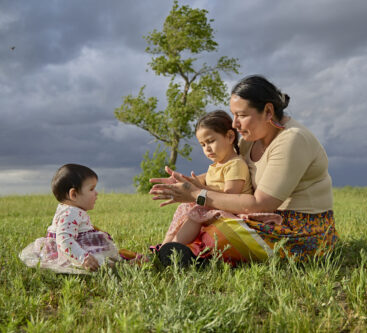
Hopkins Bloomberg Public Health Magazine
By Annalies Winny
Indigenous peoples are overcoming centuries of colonization by reclaiming the health of children and families.
Standing under the desert sun, Indigenous peoples from four different countries gather among ancient cottonwood trees. A young Māori singer, Soraya Kamau, leads the opening ceremonies with a soaring call-and-response chant. Nearby, the Rio Grande River and craggy peaks of the Sandia mountains bear witness.
A Māori ritual on the Pueblo of Santa Ana.
That call, the karanga, is an essential piece of the Māori pōwhiri, a welcome ceremony that is standard protocol when arriving as guests on someone else’s land.
“It’s a calling to all our ancestors and calling to the lands to bring us on,” explains Paula King, PhD, a Māori public health physician and clinical research fellow at the University of Otago in Wellington, New Zealand.
It was among a number of welcome rituals from Indigenous partners—all awardees in the LEGO Foundation’s Build A World of Play Challenge—who met that July evening for the first time in person, bringing together Indigenous peoples from First Nations, Canada; Aboriginal peoples from Australia; the Māori peoples from Aotearoa (New Zealand); and Indigenous hosts from the southwestern U.S. and Johns Hopkins Center for Indigenous Health. From thousands of miles apart, they came with a shared mission: to reclaim health and well-being for their youngest children and their families.
On a swath of land known as Tamaya, or “a quiet, peaceful place,” they tasted the bread of the Santa Ana Pueblo people—the food blessed by an elder from Squamish Nation in Canada. They were gifted corn necklaces made by the Santa Ana people; pressed their foreheads together in a tender Māori greeting; received beaded orange pins honoring First Nations children who never returned from residential schools. Elders from Australia brought with them a goanna lizard sculpture, a gift symbolizing connection to land. Finally, they linked arms in a joyful Zuni friendship dance.
In the spirit of kinship between guests and hosts, Melissa Sanchez of the Santa Ana Pueblo people guided the procession toward her husband, the former Pueblo War Chief Emmett Garcia, who sang in Keresan.
“You are welcome here,” Garcia told them all.
A serenade of cicadas chimed in on cue. It was an important endorsement from the natural world, Crystal Austin, of the Center for Indigenous Health and a member of the Navajo tribe, explained later. According to the Navajo creation stories, the cicada, an ancestor, sought out a new home for the Diné. “Their songs were saying on that day, ‘You are in the right place.’”
They came together to share, drawing on the power of their cultures, their common histories of European colonization that tried to erase their traditions and health, and their commitment to healing their communities by recentering their shared Indigenous views of health. Their concepts of health stretch far beyond the individual body—beyond the dominant Western biomedical concept of health as the “absence of disease”—and is instead defined by a balance of spirituality, traditional medicine, the health of Mother Earth, and the interconnectedness of all things. There’s a phrase for this in Lakota: Mitákuye Oyás’iŋ. We are all connected.
These Indigenous community strengths—rather than deficits and health inequities—are the centerpiece of the partners’ efforts to break the cycles of historical trauma and improve health outcomes in their communities. All the partners—who represent the University of Otago in New Zealand, the Batchelor Institute in Australia, the First Nations Health Authority in Canada, and the Johns Hopkins Center for Indigenous Health—have been hard at work promoting these values through their work back home. But to share the experience with understanding colleagues across the globe is nothing short of profound, says Kelly Hearn, of Te Hou Ora Whānau Services, a Māori parenting program facilitator in Dunedin, New Zealand. She agreed with the cicadas. They were all in the right place.
“When my feet hit the ground, I felt this vibration. … It was wairua [the spirit],” she says. “I felt it from generations back. There were thousands of people there.”
Now, the work could begin.
